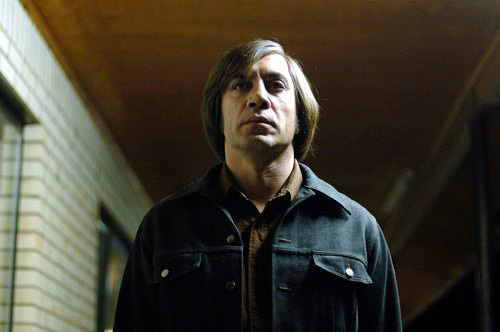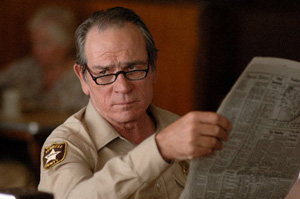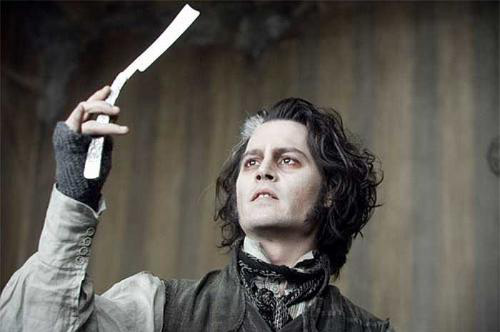|
I haven’t yet seen Paul Thomas Anderson’s There Will Be Blood—an odds-on Oscar favorite, thanks to a spate of critics’ awards—but my reaction to the title is that it’s too late, there’s blood already. David Cronenberg’s Eastern Promises and Paul Haggis’ In the Valley of Elah were reviewed in this column a few months ago. The serious films released later in 2007—not horror schlock or Fall Down Go Boom movies, I must stress—continued the vampiric bloodletting with such titles as Tony Gilroy’s Michael Clayton, Ridley Scott’s American Gangster, Ben Affleck’s Gone Baby Gone, Sidney Lumet’s Before the Devil Knows You’re Dead, the Coen Brothers’ No Country for Old Men, and Tim Burton’s Sweeney Todd: The Demon Barber of Fleet Street.
All these movies have extraordinary qualities that would make them standouts in any cinematic year; more to the point, they all present extremely harsh views of society, law enforcement, human nature, and life in general, albeit in subtly different ways. I will spare you my pop philosophizing about what such a pileup of cinematic angst says about the national mood (and I’m not even including Iraq-themed films such as Rendition, Redacted, and Lions for Lambs). I will only say that American filmgoers—those, that is, who aren’t among those who’ve already paid $175 million-plus to see Alvin and the Chipmunks—must be reeling from the unaccustomed bombardment of serious moral questions. The moral dilemma that ends Gone Baby Gone still haunts me three months after I encountered it. Michael Clayton portrays the moral re-education of a law firm’s “fixer” when he finds he and his friends are about to get fixed themselves. Before the Devil Knows You’re Dead combines Martin Scorsese with Arthur Miller, depicting the destruction of a family from within because of criminal weakness and greed. American Gangster touches on similar family issues—is it possible to extol love of family and still pistol-whip family members who get out of line?—but mostly portrays a society of endemic corruption, in which the line between lawbreaker and law enforcer is almost nonexistent.
All these films don’t lack for blood, but in No Country for Old Men and Sweeney Todd, blood qualifies as a major character. It gushes and leaps at the audience, puddling and lapping everywhere, possessing at least as much of a life as the characters from whom it spurts. It is part villain, part captive, impatient to be freed by those who appoint themselves as liberators.
Certainly No Country for Old Men’s Anton Chigurh (Javier Bardem) regards himself, if not as a liberator, then as a moral arbiter. Chigurh is self-appointed judge, jury and executioner to everyone who draws his attention in any way. He regards all human beings except himself as insects, worthy only of extermination. Those who stand between him and what he wants, he kills. Those he simply happens to notice, he offers a coin toss and a fifty-fifty chance at life. Those who refuse the bet elicit his rage and instant death—which in practice means that those too dumb to understand the bet have a better chance at survival. Chigurh is remorseless, relentless, and fastidious, constantly checking his person to make sure no drop of blood has tainted it.
 |
Chigurh is the perfect representative of the philosophy of Cormac McCarthy, an author whose fiction makes No Exit look like a Waltons marathon. In McCarthy’s world, young men suffer and die horribly in futile attempts to improve their lot; old men, having been passed over arbitrarily by fate, meditate on the brutality of the world and their imminent mortality. Women, depending on the story at hand, serve either as temptresses or as collateral casualties. Anton Chigurh—literally or figuratively—can show up anytime, anywhere.
All the Pretty Horses, the previous attempt to film a McCarthy novel, failed largely because director/screenwriter Billy Bob Thornton softened McCarthy’s scalding pessimism. Joel and Ethan Coen were far less likely to flinch from McCarthy’s message, and in No Country for Old Men, they did not. The Coens’ best and most famous previous film was Fargo, but even that blood-soaked film was a Disneyfied cheerfest compared with McCarthy’s vision; if McCarthy had written Fargo, Marge Gunderson and her unborn child would have followed Carl Showalter into Gaear Gunsrud’s woodchipper. The Coens of No Country for Old Men are the Coens of Blood Simple and The Man Who Wasn’t There, two utterly bleak films about morally tainted characters too stupid to realize they’re drifting toward doom in a meaningless universe.
No Country for Old Men marries the cinematic brilliance of Fargo to the hopelessness of The Man Who Wasn’t There (which, ironically, starred Billy Bob Thornton). Roger Deakins, the Coens’ masterful cinematographer, captures the empty, parched plains of Texas—a setting Samuel Beckett might have envied—just as magnificently as he did the empty, snow-covered Minnesota prairie of Fargo. In their panoramic silence, the opening shots build an impressive and appropriate sense of danger, as antelope hunter Llewellyn Moss (Josh Brolin) discovers signs of disquiet in the arid landscape that lead him to the scene of a hideous massacre—a drug deal gone radically wrong. Moss takes the $2 million in payoff money, making him a target for both factions of drug dealers (one of which, to its own misfortune, hires Chigurh as its hit man). Moss turns out to be a man of remarkable grit and resourcefulness, a modern-day cowboy hero, and the Universe shrugs in response.
Some commentators have complained about the lack of resolution in the story of No Country for Old Men. I beg to differ; there is a plot resolution—not quite the one you expect, and requiring some mental interpretation, yet appropriate to the material. But it cuts the audience off so emphatically from the traditional pleasures of crime drama, Westerns and even film noir that many viewers just can’t believe it. The horror of the world goes on, except for those for whom it doesn’t. Some are harder to kill than others, and some are just—temporarily—luckier.
Bardem, who burst on the American cinematic scene with his superb performance as Cuban author Reinaldo Arenas in Julian Schnabel’s Before Night Falls, has been winning critics’ awards in truckloads for his eerie, unnerving turn as Chigurh. He is indeed deserving, but unfortunately the singularity of the Chigurh character has deflected attention from the equally fine work of Brolin as Moss. Brolin, a Hollywood journeyman from his early teens, announced himself as an important actor in 2007 playing two very different characters—a sleazy, murderous cop in American Gangster, and the stalwart, Gary-Cooperish Moss.
Sheriff Ed Tom Bell, one of McCarthy’s patented melancholics commenting on the ongoing bloodbath of the world, is played by the great Tommy Lee Jones;  it’s a less commanding part for Jones than his role in In the Valley of Elah,but he’s still wonderful. So are the other members of the large and excellent cast typical of a Coen Brothers film, including Woody Harrelson, Tess Harper, Kelly Macdonald, Barry Corbin, Garret Dillahunt, Beth Grant, Gene Jones and Stephen Root. Everything about No Country for Old Men is first-rate, and the film is exciting to watch, if not precisely pleasurable. it’s a less commanding part for Jones than his role in In the Valley of Elah,but he’s still wonderful. So are the other members of the large and excellent cast typical of a Coen Brothers film, including Woody Harrelson, Tess Harper, Kelly Macdonald, Barry Corbin, Garret Dillahunt, Beth Grant, Gene Jones and Stephen Root. Everything about No Country for Old Men is first-rate, and the film is exciting to watch, if not precisely pleasurable.
Sweeney Todd, a/k/a Benjamin Barker, is a very different kind of serial killer from Anton Chigurh, just as the highly stylized Sweeney Todd is a very different kind of film from the hyper-realism of No Country for Old Men. Whereas Chigurh is motivated by cold-blooded contempt for humanity, Todd is driven by hot-blooded need for revenge against the evil Judge Turpin (Alan Rickman) and Beadle Bamford (Timothy Spall) who had him transported to Australia for a crime he didn’t commit. Back in England after fifteen years, he seeks their blood; foiled in his quest, he turns his vengeance toward the whole world. “And we all deserve to die—/Even you, Mrs. Lovett, even I!” Todd (Johnny Depp) sings to his accomplice Mrs. Lovett (Helena Bonham Carter); this alone sets him apart from Chigurh, who believes he and he alone has the right to live.
Nevertheless, the practical results are the same, as Todd sends victim after victim of his razor down the chute to Mrs. Lovett’s pie oven. Whereas Todd is kill-crazy, Mrs. Lovett is the ultimate sociopath, matter-of-factly helping Todd for kicks and for what she can get out of it: a revitalized meat-pie business, a replenished bank account, and what she hopes will be a romance with Todd. Ultimately—on this basis and for various misrepresentations she makes to Todd, no fair asking what—she proves herself the more evil of the two.
I still regard the original 1979 Broadway production of Sweeney Todd,starring Len Cariou and Angela Lansbury, as one of the best things I have ever seen on stage, and like all other fans of that production I wondered if Tim Burton could possibly do justice to it. Fortunately, he could and did. His Sweeney Todd stands as a textbook example of how to make a Broadway musical cinematic while retaining the atmosphere and impact of the stage piece. Screenwriter John Logan does a fine job of adapting Hugh Wheeler’s libretto, and Burton marshals his superb crew—including cinematographer Dariusz Wolski, production designer Dante Ferretti and costume designer Colleen Atwood—to create a brooding, malevolent early-Victorian London that is a perfect match for the gory melodrama. Burton might go a little heavy on the CGI for some tastes, but he also underlines the savage inhumanity of the story’s time period in ways Dickens himself might have applauded; for instance, when Turpin sentences a prisoner to the gallows, the camera pans to the figure in the dock—a weeping, red-haired boy of about ten. Burton also stages the musical numbers imaginatively, in ways that open up the movie; when Mrs. Lovett sings “By the Sea,” the film’s dark palette changes suddenly to candy-colored pastels, underscoring hilariously and tragically the sheer impossibility of her daydream.
My greatest fear—and everyone else’s—was that the biggest losers in the film of Sweeney Todd would be the music and lyrics of Stephen Sondheim, arguably the best and most haunting ever written for Broadway. Again, my fears proved unfounded. I might quibble with a few of the cuts Burton made in such songs as “A Little Priest,” a glorious masterpiece of black-comic verse, but the song’s impact remains. I might also mourn the loss of such songs as “The Ballad of Sweeney Todd” (which appears as the opening theme music, but is never sung) and the love duet between lovelorn sailor Anthony Hope and Turpin’s abused ward Johanna. In general, however, Sondheim’s score is given its due, even with a Todd and Mrs. Lovett who are not known for their singing abilities. As it happens, Bonham Carter is an adequate singer, Depp somewhat better than adequate, but both are such brilliant actors that any vocal limitations on their part immediately become irrelevant.

The best singing voices in the movie belong to Jamie Campbell Bower, who looks and sounds like a Botticelli angel as Anthony Hope; Laura Michelle Kelly, a poignant Beggar Woman; and Ed Sanders, who as Toby Ragg is a smashing combination of Oliver Twist and the Artful Dodger. All the film’s actors—with the single, unfortunate exception of Jayne Wisener as Johanna—make strong impressions, including Rickman as the diabolically lustful Turpin, Spall as the mincingly brutal Bamford, and Sacha Baron Cohen, who mixes Borat with Chico Marx to create the mountebank Pirelli.
Above all, Burton understands that Sweeney Todd is a story that must sweep up the audience in its bloody embrace. Harold Prince, director of the original production, understood this very well, and Burton matches Prince on that score. A few months ago I saw the touring company of the musical’s latest version, which takes place on a simplified stage with the various performers playing musical instruments as well as singing. I was impressed by the level of talent displayed—particularly that of young Edmund Bagnell, who played the violin and clarinet as well as singing beautifully in the role of Toby Ragg—but the production as a whole left me cold. Bertolt Brecht would have loved the distancing effect; I did not.
On the other hand, Burton and his performers, particularly Depp, keep the audience enthralled from beginning to end. The final scene, with the flame from Mrs. Lovett’s oven illuminating a cellar littered with corpses, rises above melodrama to achieve a sense of tragedy that approaches the Shakespearian. That tragedy—with its death of hope signifying that hope existed in the first place—contrasts with the overwhelming sense of despair that envelops No Country for Old Men. That is why, for me, Sweeney Todd is the more enjoyable film, and the film I feel more inclined to see again.
|
|
